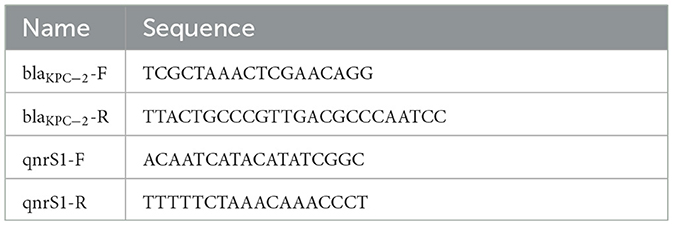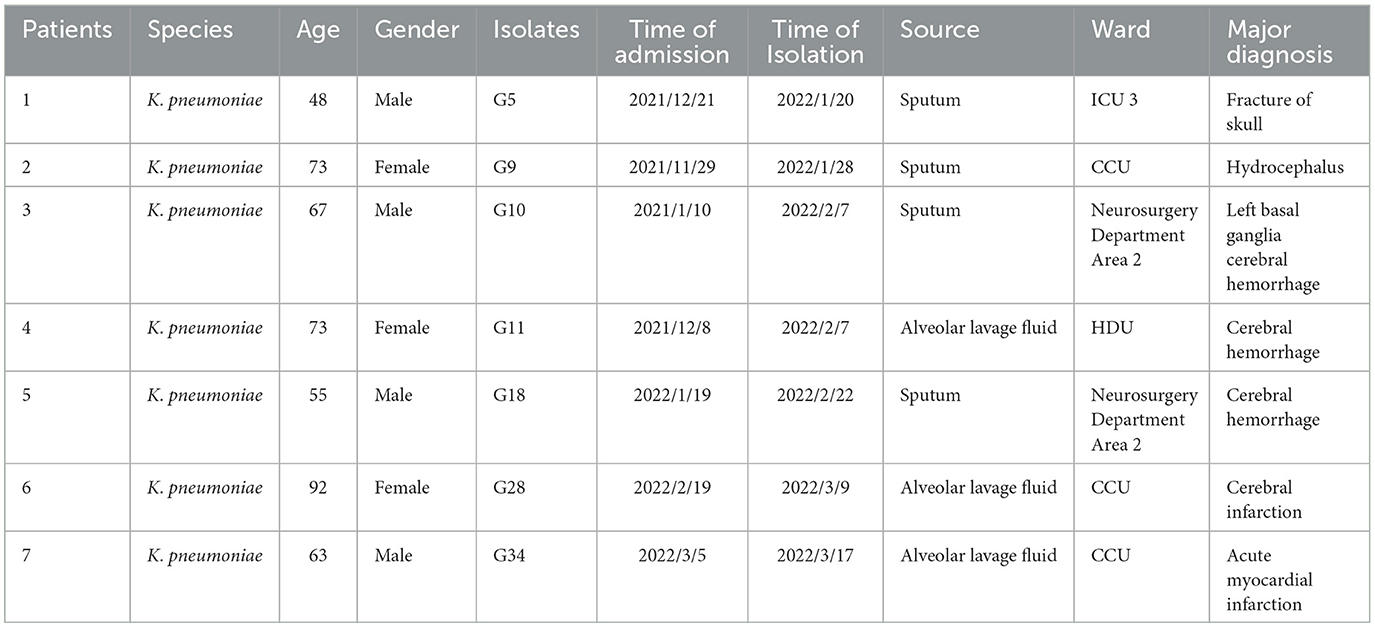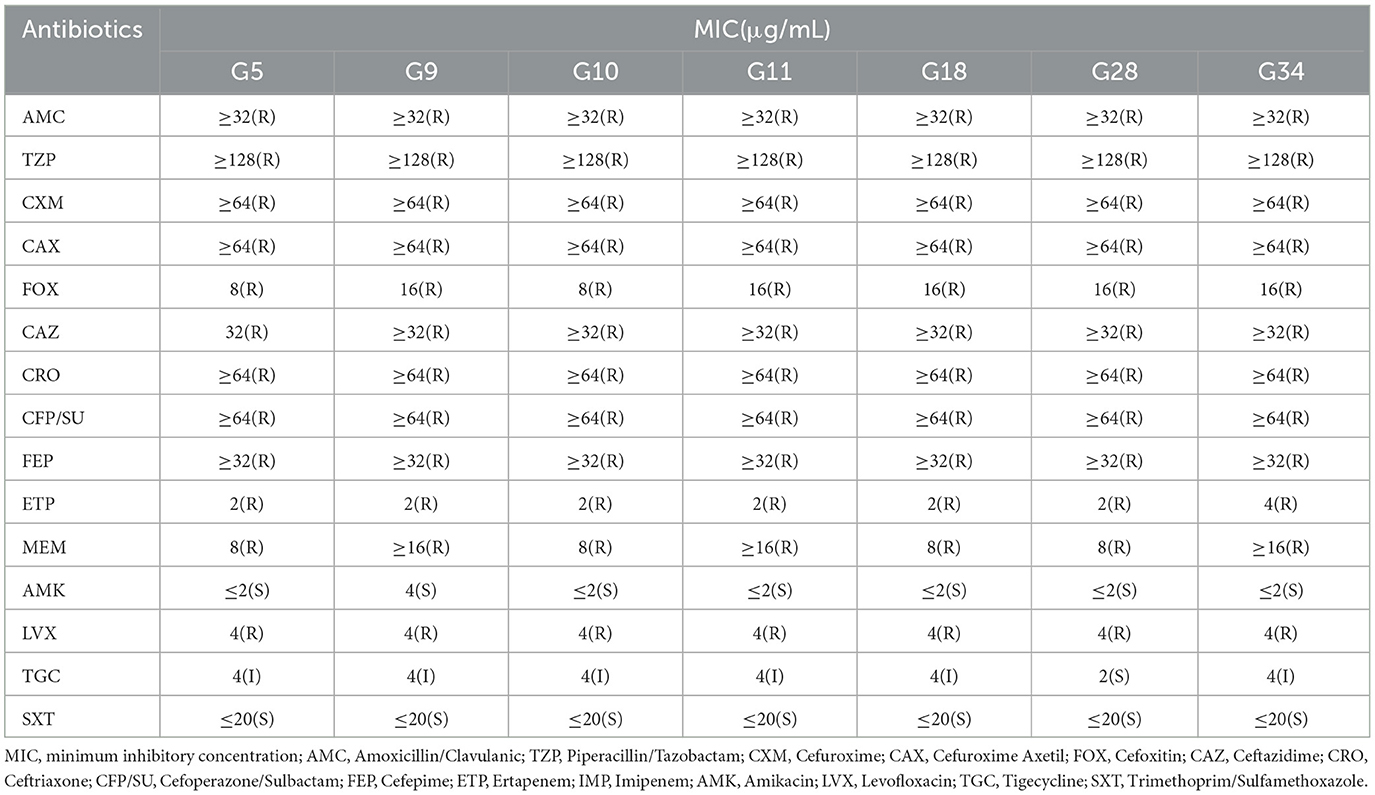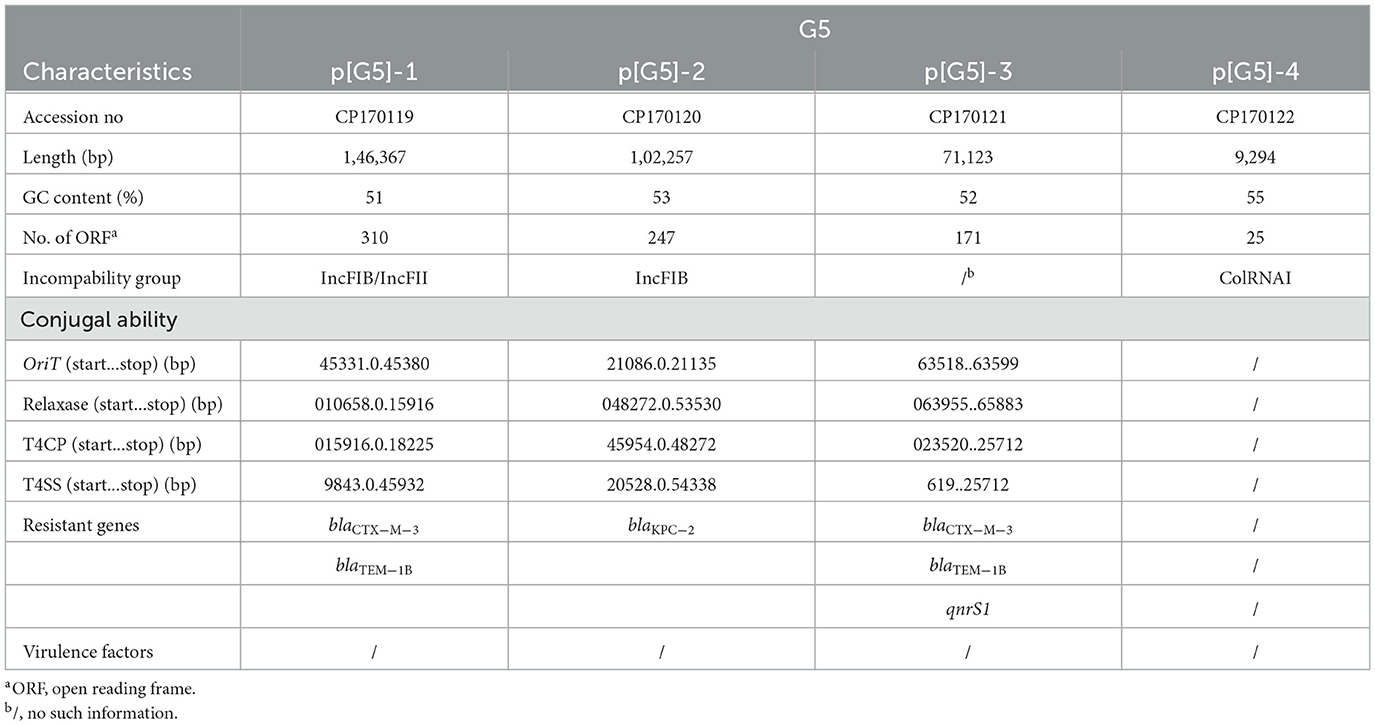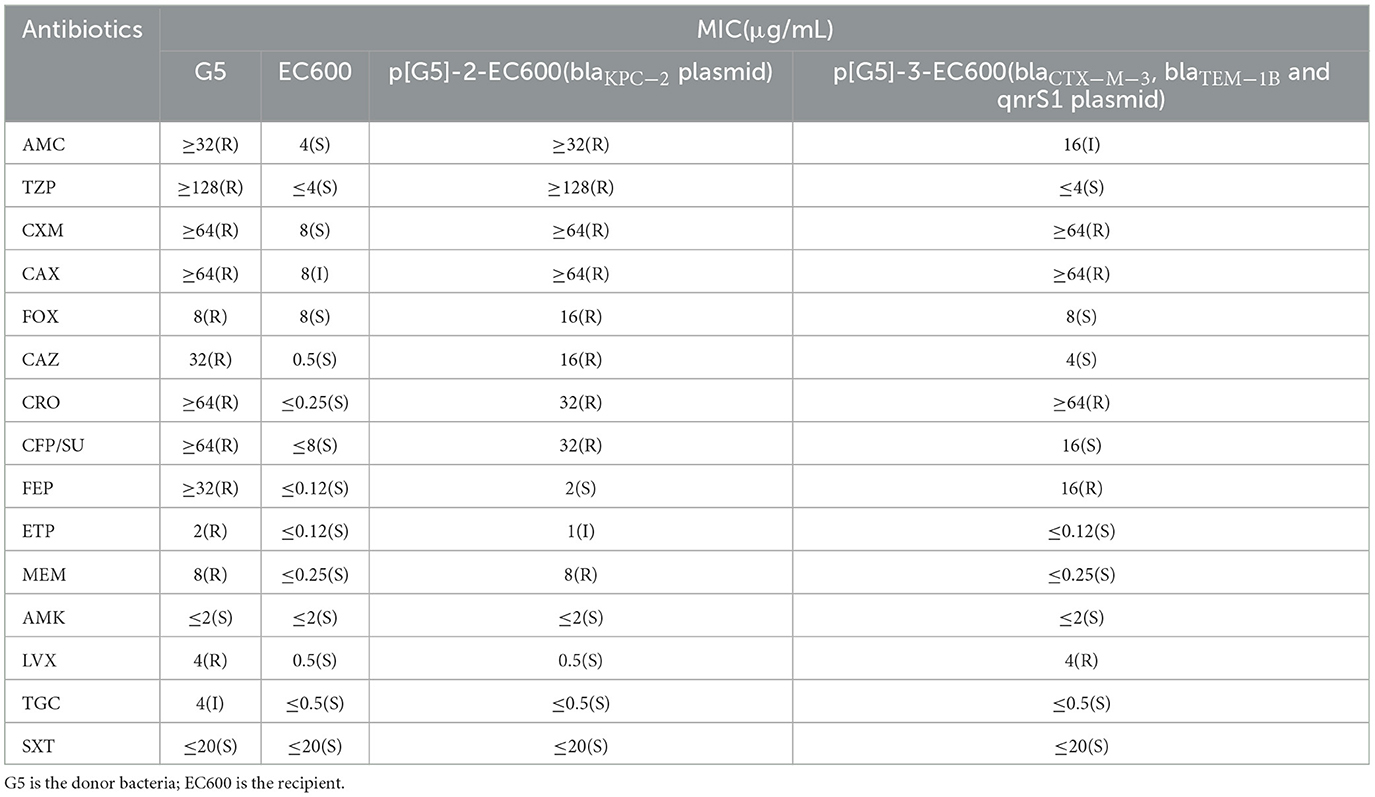- 1Department of Clinical Laboratory, Shanghai Pulmonary Hospital, School of Medicine, Tongji University, Shanghai, China
- 2School of Public Health, Jiangxi Medical College, Nanchang University, Nanchang, China
- 3Department of Laboratory Medicine, The First Affiliated Hospital of Wenzhou Medical University, Wenzhou, China
Background: The global emergence of carbapenem-resistant Klebsiella pneumoniae (CRKP) has become a critical public health threat. However, the epidemiological significance of certain sequence types (STs) remains underappreciated. Among these, ST792—a lineage rarely documented in global surveillance studies—has recently emerged as a concerning threat in southern China. In this study, we characterized the epidemiological features and antimicrobial resistance mechanisms of CRKP ST792 isolates collected during a dissemination in a hospital in southern China.
Methods: Seven separate clinical isolates were collected from hospitalized patients between January 2021 and March 2022. Bacterial isolates were identified, and antimicrobial susceptibility testing was conducted using the VITEK-2 compact automated system. Whole-genome sequencing (WGS) was performed on all seven isolates to confirm the presence of resistance genes. Additionally, a representative strain (G5) was selected for in-depth genomic characterization using long-read sequencing to analyze its genetic features and mobile genetic elements. Conjugation experiments were conducted to assess the transferability of the resistance plasmids.
Results: All isolated strains were identified as ST792-type CRKP carrying blaKPC − 2 through whole-genome sequencing. The strains harbored additional resistance genes including blaSHV − 148, blaCTX − M−3, blaTEM − 1B, qnrS1, OqxA and OqxB. Genomic characterization of representative strain G5 revealed a circular chromosome and three resistance plasmids. The blaKPC − 2 gene was located on a 102,257 bp IncFIB(pQil) plasmid with a Tn3-TnpR-ISKpn27-ISKpn28-blaKPC − 2-ISKpn6 genetic structure. Conjugation experiments demonstrated successful transfer of two accessory plasmids (p[G5]-2 and p[G5]-3) to Escherichia coli EC600, confirming their mobility and potential role in resistance gene dissemination.
Conclusion: This study characterizes the nosocomial dissemination of KPC-2-producing K. pneumoniae ST792 strains, elucidating their antimicrobial resistance patterns and plasmid-mediated transmission mechanisms to inform infection control strategies. The urgent need for enhanced surveillance and strict implementation of infection control measures is underscored to mitigate the spread of hospital-acquired multidrug-resistant pathogens.
Introduction
Klebsiella pneumoniae, a Gram-negative opportunistic pathogen of the Enterbacteriaceae, is a leading cause of nosocomial infections including pneumonia, soft tissue infection, urinary tract infection and septicemia (Podschun and Ullmann, 1998). Carbapenems, along with other β-lactam antibiotics, serve as first-line therapeutics for severe K. pneumoniae infections and represent last-resort options for multidrug-resistant (MDR) cases. Since the first reported isolation of carbapenem-resistant K. pneumoniae (CRKP) in the 1990s (MacKenzie et al., 1997), these resistant pathogens have rapidly disseminated globally (Clancy et al., 2013; Xu et al., 2017; Zheng et al., 2018). CRKP infections pose a critical public health challenge, associated with significantly higher mortality rates particularly among immunocompromised patients and those in intensive care settings (Karampatakis et al., 2023).
The antimicrobial resistance mechanisms of CRKP are mediated through three principal pathways: (1) enzymatic inactivation via β-lactamase production, including extended-spectrum β-lactamases (ESBLs) and carbapenemases; (2) enhanced efflux pump activity; and (3) structural modifications of outer membrane proteins (Pu et al., 2023). Among these, carbapenemase production has been established as the predominant resistance mechanism in CRKP clinical isolates (Gandra and Burnham, 2020; Karaiskos et al., 2021). Carbapenemases are phylogenetically classified into three molecular classes (A, B, and D). Among class A carbapenemases, KPC-type enzymes represent the most clinically significant group (Zhang et al., 2017), with phylogenetic analyses identifying numerous variants (KPC-2 through KPC-157) across different geographical regions (Naas et al., 2017).
The KPC enzyme was first identified in a clinical isolate of K. pneumoniae from North Carolina, USA, in 1996 (Seki et al., 2011). Since its initial detection, the global prevalence of KPC-producing strains has increased dramatically (Yigit et al., 2001; Nordmann et al., 2009). While numerous KPC variants have been characterized, epidemiological surveillance indicates that KPC-2 and KPC-3 remain the predominant variants worldwide (Walther-Rasmussen and Høiby, 2007). Geographic distribution patterns reveal distinct genotype predominance: blaKPC − 3 represents the major genotype in the United States (Sader et al., 2017), whereas blaKPC − 2 dominates in China (Zhang et al., 2018). The spread of blaKPC involves clonal expansion, horizontal transfer, and dissemination via plasmids. In healthcare settings, the emergence of KPC-producing K. pneumoniae has been largely driven by specific epidemic clones (Cuzon et al., 2010). ST258 prevails as the dominant sequence type in the United States (Kitchel et al., 2009), while ST11 clones account for most clinical isolates in China (Qi et al., 2011). These high-risk clones have become a major focus of antimicrobial resistance research due to their rapid global dissemination and association with treatment failures (Dong et al., 2018; Munoz-Price et al., 2013).
K. pneumoniae ST792 represents a distinct sequence type within the multilocus sequence typing (MLST) classification system. While demonstrating lower global prevalence compared to pandemic clones like ST258 and ST11, ST792 has been identified across multiple geographical regions including Europe (Jati et al., 2023), Asia (Anuar et al., 2024), North America (Wang et al., 2013), and the Middle East (Eltai et al., 2020). Clinical isolates are primarily recovered from both healthcare-associated and community-acquired infections, with specimen sources encompassing rectal colonization, urinary tract infections, wound infections, and respiratory tract infections. Most ST792 strains exhibit MDR without carbapenemase production, as exemplified by a United States isolate carrying CTX-M-2, SHV-11 and TEM-1 (Wang et al., 2013), and an ESBL-producing strain from Malaysia (Anuar et al., 2024). However, rare cases of carbapenem-resistant ST792 have been reported, such as a KPC-2-producing ST792 isolate documented in Singapore (Octavia et al., 2019). To date, few studies have systematically investigated the nosocomial transmission dynamics of ST792 CRKP carrying KPC-2 or the mobility of its drug-resistant plasmids in clinical settings.
In this study, we characterized a hospital-based dissemination of ST792 CRKP harboring blaKPC − 2 between intensive care and neurosurgery units. Through whole-genome sequencing, we elucidated the molecular resistance mechanisms and transmission pathways to guide clinical anti-infective treatment and infection control measures against resistant strain transmission.
Materials and methods
Bacterial isolation and clinical information
Between January 2021 and March 2022, seven nonrepeated CRKP isolates were collected from a tertiary hospital in Ganzhou, Jiangxi Province, China. All strains were isolated from patients aged >45 years with severe underlying conditions. Isolates G5, G9, G10 and G18 were obtained from sputum specimens, while G11, G28 and G34 were recovered from bronchoalveolar lavage fluid. The patients exhibited diverse clinical presentations: the G5-infected individual from the intensive care unit (ICU) was diagnosed with skull fracture; G9, G28, and G34 were isolated from cardiac care unit (CCU) patients with hydrocephalus, cerebral infarction, and acute myocardial infarction, respectively; G10 and G18 originated from Neurosurgery Department Area two cases with left basal ganglia hemorrhage and cerebral hemorrhage; and G11 was cultured from a high-dependency unit (HDU) patient with cerebral hemorrhage. All isolates demonstrated carbapenem-resistant phenotypes by VITEK-2 Compact system analysis, using Escherichia coli ATCC 25922 as the quality control strain for antimicrobial susceptibility testing (AST).
Antimicrobial susceptibility testing
The minimum inhibitory concentrations (MICs) of Amoxicillin/Clavulanic acid, Piperacillin/Tazobactam, Cefuroxime, Cefuroxime axetil, Cefoxitin, Ceftazidime, Ceftriaxone, Cefoperazone/Sulbactam, Cefepime, Ertapenem, Imipenem, Amikacin, Levofloxacin, Trimethoprim/Sulfamethoxazole were determined using the VITEK 2 Compact system (bioMérieux, France), with results interpreted according to Clinical and Laboratory Standards Institute (CLSI2022-M100-ED31) guidelines. For tigecycline, MIC was assessed via broth dilution in Mueller-Hinton broth, with interpretation based on European Committee on Antimicrobial Susceptibility Testing (EUCAST 2022) breakpoint. Quality control was performed using Escherichia coli ATCC 25922 for all antimicrobial susceptibility testing procedures to ensure accuracy and reproducibility.
Whole genome sequencing and bioinformatics analysis
Genomic DNA was extracted using a commercial genomic DNA extraction kit (Qiagen, Germany) following the manufacturer's protocol. Whole genome sequencing was performed using both short-read and long-read sequencing technologies. For short-read sequencing, paired-end libraries (2 × 125 bp) were prepared and sequenced on the Illumina NovaSeq 6000 platform. Long-read sequencing was conducted using the PacBio Sequel platform with a 10-kb insert library. Raw sequencing data were processed by removing adapter sequences using AdapterRemoval (Lindgreen, 2012) and quality filtering with SOAPec (Luo et al., 2012). High-quality reads were de novo assembled into contigs and scaffolds using SPAdes v3.12 (Bankevich et al., 2012) and A5-miseq v20160825 (Coil et al., 2015). PacBio long reads were assembled using CANU v.1.7.1 (Koren et al., 2017). The final genome sequence was generated by integrating both Illumina and PacBio assemblies, followed by error correction using Pilon v1.23. The assembled genome was annotated using Prokka v1.14.6 (Seemann, 2014) and the RAST server v2.0 (Brettin et al., 2015). Multi-locus sequence typing (MLST) was performed using MLST v2.23.0 (https://cge.cbs.dtu.dk/services/MLST/), while capsular serotyping and virulence factor identification were conducted using Kleborate v2.0.0 (https://github.com/katholt/Kleborate). Antibiotic resistance genes were identified using ResFinder 4.1 (https://cge.cbs.dtu.dk/services/ResFinder/) with default parameters. Core genome SNPs were identified through stringent filtering excluding: (i) low-complexity regions (<200 bp), (ii) 100-bp windows with <50% column consistency, and (iii) 100-bp windows containing >20 indels. Maximum-likelihood trees were reconstructed using RAxML-NG (GTR+GAMMA model, 1,000 bootstraps) based on the filtered core SNP alignment, with pairwise SNP distances calculated using MEGA-CC. Plasmid analysis included conjugation potential prediction using oriTfinder (http://bioinfo-mml.sjtu.edu.cn/oriTfinder/) and visualization with Proksee v1.2.0 (https://proksee.ca/). The genetic environment surrounding blaKPC − 2 in plasmid p[G5]-2 was compared with reference sequence pKPHS2_KPC-2 using Easyfig v2.2.3. A Minimum Spanning Tree (MST) was constructed using PhyloViz 2.0 based on over 8,000 K. pneumoniae STs from the Pasteur MLST database (PubMLST) (Institute Pasteur, 2025). The complete genomic sequence of G5 has been deposited in GenBank under accession no. CP170118. We also deposited the raw reads of the genomes of the remaining six strains we sequenced in GenBank (Bioproject accession no. PRJNA1253637).
Conjugation experiments
To assess the transferability of resistance plasmids from K. pneumoniae G5, a conjugation assay was performed using rifampicin-resistant E. coli EC600 as the recipient strain. Donor and recipient cultures were grown to logarithmic phase, mixed at a 1:9 ratio, pelleted by centrifugation (8,000 × g, 2 min), and resuspended in 20 μL of LB broth. After 24 h of incubation at 37°C, transconjugants harboring p[G5]-2 were selected on LB agar supplemented with rifampicin (200 μg/mL) and meropenem (1 μg/mL), while transconjugants carrying p[G5]-3 were selected using rifampicin (200 μg/mL) and ciprofloxacin (10 μg/mL). Conjugation frequency was calculated as the number of transconjugants per donor cell. Successful plasmid transfer was confirmed via PCR amplification of blaKPC − 2 and qnrS1 using primers listed in Table 1. Additionally, the MICs of transconjugants were determined using the VITEK-2 Compact system to evaluate phenotypic resistance profiles.
Results
The clinical features of ST792 Klebsiella pneumoniae
From January 10, 2021, to March 17, 2022, we conducted whole-genome sequencing on all CRKP isolates collected from a tertiary hospital in southern China. Genomic analysis revealed seven KPC-2-producing ST792 K. pneumoniae strains isolated from distinct patients. The uncommon detection frequency of ST792 K. pneumoniae prompted further analysis of its epidemiological characteristics. These strains were isolated from respiratory specimens, including sputum (n = 4) and bronchoalveolar lavage fluid (n = 3). The first blaKPC − 2-positive isolate was detected in January 2022 from a patient admitted to the ICU following a skull fracture. A CRKP strain was recovered from the patient's sputum after 30 days of hospitalization. Subsequent CRKP isolates (n = 3) were identified in multiple hospital wards, including the CCU (n = 1), HDU (n = 1), ICU (n = 1), and Neurosurgery Department Area 2 (n = 2) (Figure 1).
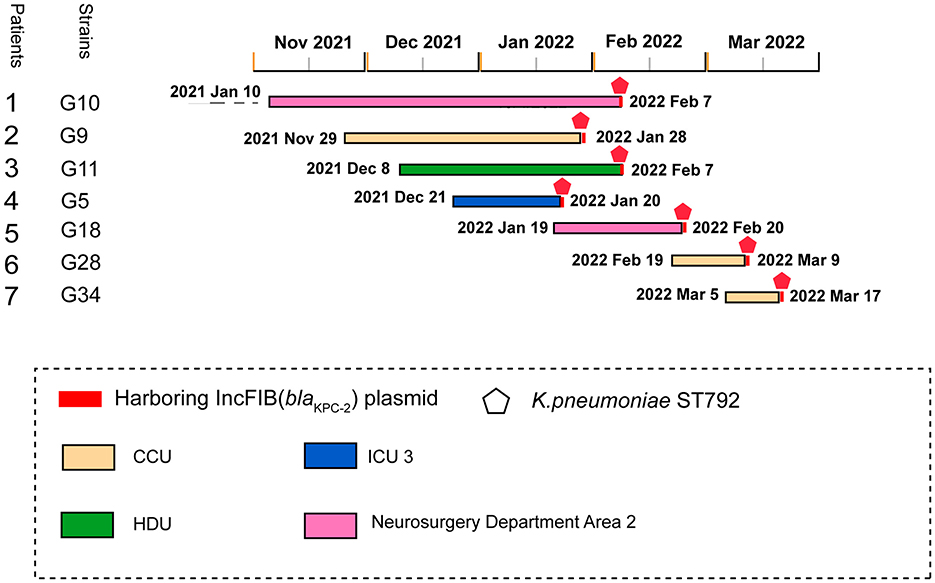
Figure 1. Dissemination timeline of KPC-2-producing K. pneumoniae infection at a tertiary hospital in Ganzhou, Jiangxi Province, China. CCU, cardiac care unit; HDU, high dependency unit; ICU, intensive care unit.
The median patient age was 67 years (range: 48–92), with a male predominance (57.1%). All blaKPC − 2-positive isolates were detected ≥10 days post-admission (range: 12–393 days). Underlying conditions included cerebral hemorrhage (n = 3), hydrocephalus (n = 1), cerebral infarction (n = 1), skull fracture (n = 1), and acute myocardial infarction (n = 1). Of these patients, 57.1% underwent surgical procedures, and all received mechanical ventilation and carbapenem antibiotics prior to CRKP detection (Table 2).
Antimicrobial susceptibility and resistance genes
During antimicrobial susceptibility testing of the seven ST792 CRKP isolates against 15 antibiotics, all strains demonstrated resistance to amoxicillin/clavulanic acid, piperacillin/tazobactam, cefuroxime, cefuroxime axetil, cefoxitin, ceftazidime, ceftriaxone, cefoperazone/sulbactam, cefepime, ertapenem, imipenem, and levofloxacin, while remaining susceptible to amikacin and trimethoprim/sulfamethoxazole (Table 3). Genomic analysis revealed that all CRKP isolates harbored multiple resistance genes, including blaKPC − 2, qnrS1, blaCTX − M−3, blaSHV − 1, and blaTEM − 1B. The presence of qnrS1 correlated with ciprofloxacin resistance, blaKPC − 2 mediated resistance to cephalosporins and carbapenems, blaSHV − 1 and blaTEM − 1B conferred ampicillin resistance, and blaCTX − M−3 was associated with resistance to both ampicillin and ceftriaxone, collectively explaining the observed multidrug-resistant phenotype.
Molecular epidemiology
MLST analysis of 7 housekeeping genes of K. pneumoniae showed that all 7 CRKP isolates belonged to the ST792 strain. For the seven isolates, we constructed a phylogenetic using maximum likelihood based on the core genomic SNPs, and the results were divided into three subgroups, G11, G9 and G10 with highly homology, G34, G18 and G5 with high homology, G28 is a separate subgroup (Figure 2, Supplementary Table 2). To trace phylogenetic origins and characterize population structure, we performed comparative genomic analysis of our ST792 isolates with publicly available ST792 strains from National Center for Biotechnology Information (NCBI) RefSeq database (https://www.ncbi.nlm.nih.gov/refseq [accessed May 10, 2025]). Our analysis revealed that the seven ST792 isolates from this study formed a distinct cluster, evolutionarily distant from four other ST792 strains from different countries, suggesting independent origins. Notably, all seven isolates in our study carried the blaKPC − 2 gene and were carbapenem-resistant, whereas the four comparator strains were susceptible to carbapenems and lacked this resistance determinant (Supplementary Figure 1, Supplementary Table 3).

Figure 2. Distribution of resistance genes of ST792 CRKP isolates. The phylogenetic showed that the ST792 CRKP isolates were divided into three subgroups. Resistance genes are labeled in blue, with blank spaces indicating gene absence.
MLST-based minimum spanning tree construction
The MST analysis revealed that ST792 is directly connected to its two closest phylogenetic relatives—ST1373 and ST5091—which differ by two housekeeping gene loci (infB and pgi) and one locus (tonB), respectively (Supplementary Figure 2, Supplementary Table 1). Notably, both ST1373 and ST5091 are rare STs in K. pneumoniae, suggesting potential niche adaptation or limited transmission of these closely related variants.
The characteristic analysis of G5 plasmids
Given identical genomic profiles among all seven ST792 isolates by Illumina sequencing, we selected G5 (the first isolated strain) for PacBio long-read sequencing to elucidate resistance gene contexts and transmission-relevant genomic features. The draft genome of K. pneumoniae G5 comprises 5,744,391 bp with an N50 of 5,415,350 bp and a guanine and cytosine content of 57%. The genome consists of a circular chromosome of 5,415,350 bp and four plasmids: p[G5]-1 (146,367 bp), p[G5]-2 (102,257 bp), p[G5]-3 (71,123 bp), p[G5]-4 (9,294 bp). Prokka annotation identified 5,067 protein-coding genes and 111 RNA genes on the chromosome (Figure 3).
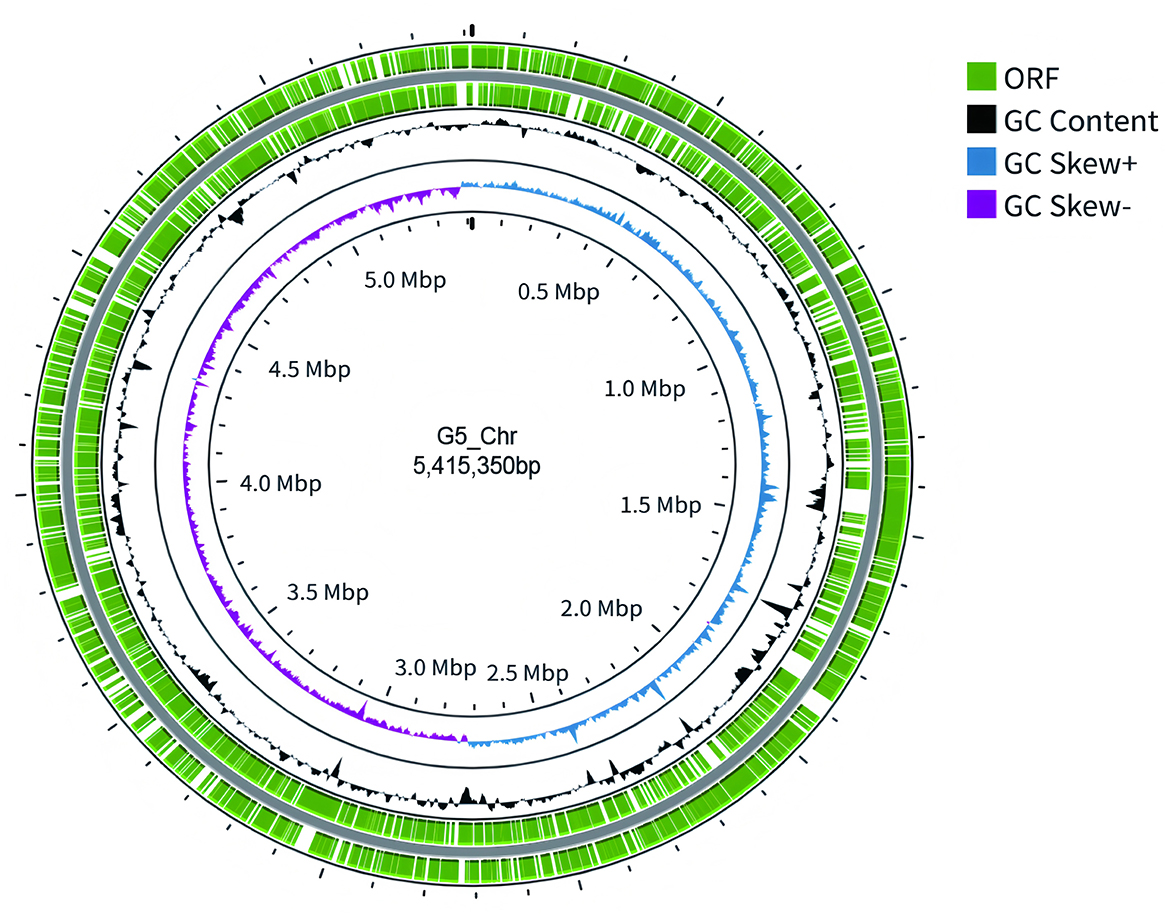
Figure 3. Schematic circular genome of G5. Moving from the outermost to the innermost circles: the first and second circles highlight the coding sequences on the positive and negative strands, respectively; the third circle charts the GC content, with heightened levels indicated on the exterior, suggesting these areas have a higher GC content than the genome average; the fourth circle depicts the GC skew values.
Whole-genome sequencing analysis identified three resistance plasmids in this isolate (Table 4), with particular attention given to blaKPC − 2, a critical determinant of carbapenem resistance. The plasmid p[G5]-2, which carries the carbapenem resistance gene blaKPC − 2, belongs to the IncFIB(pQil) incompatibility group. A schematic representation of the genetic environment of the blaKPC − 2 genes on the p[G5]-2 is shown in Figure 4A. The analysis further revealed that plasmids p[G5]-1 and p[G5]-3 carry multiple resistance determinants contributing to the strain's multidrug-resistant phenotype. Specifically, p[G5]-1 harbors extended-spectrum β-lactamase genes (blaCTX − M−3 and blaTEM − 1B), while p[G5]-3 contains both these β-lactamase genes along with the fluoroquinolone resistance determinant qnrS1.
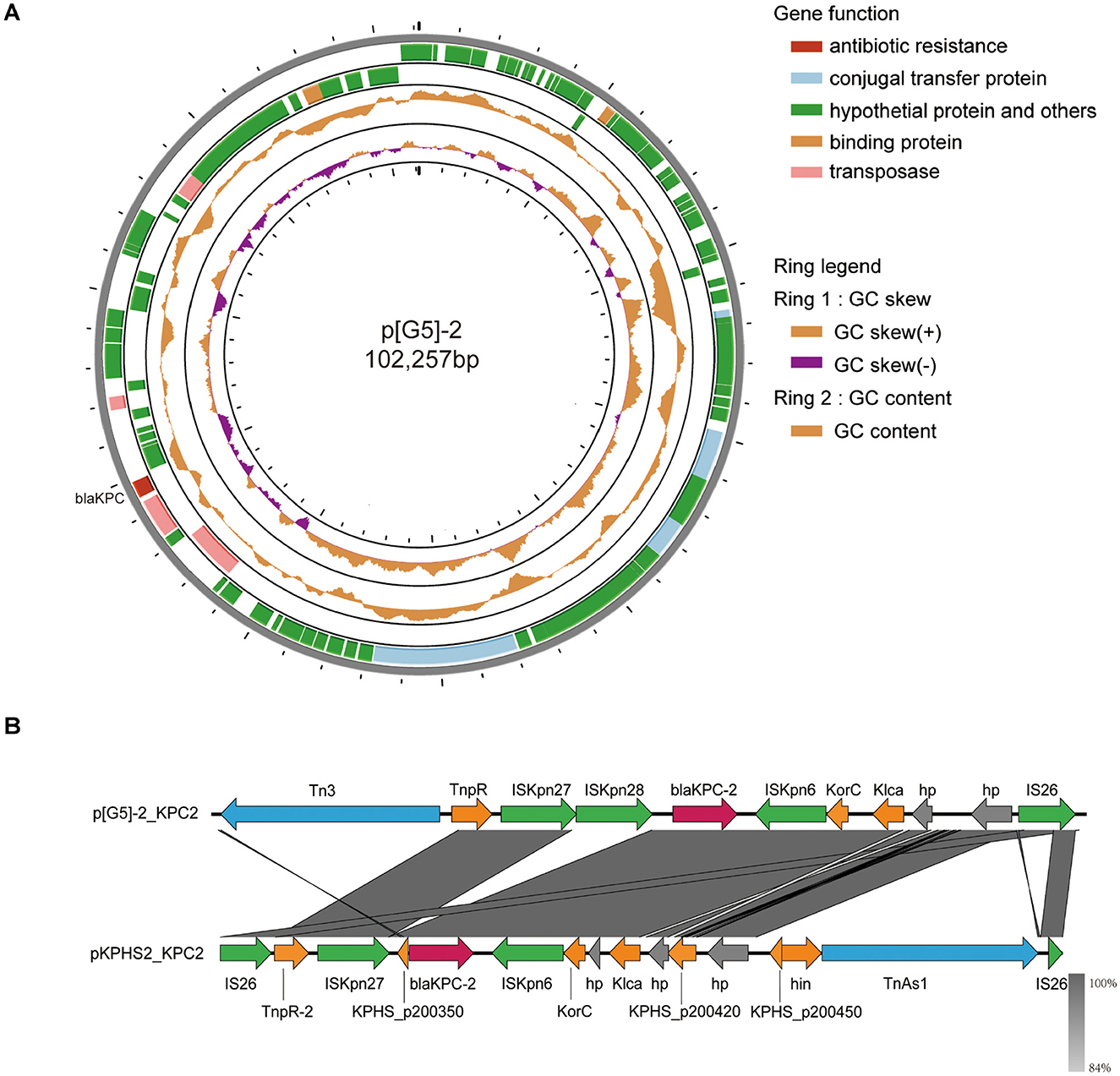
Figure 4. (A) Circular map of p[G5]-2 of K. pneumoniae G5. (B) Linear comparison of the blaKPC − 2 region of p[G5]-2 and plasmid pKPHS2. Open reading frames are portrayed by arrows and are depicted in different colors on the basis of their predicted gene functions. Red arrows indicate resistance genes, blue arrows indicate transposon, green arrows indicate insertion sequence, orange arrows represent the backbone genes of the plasmid, and gray arrows indicate hypothetical protein.
Genetic environment of blakpc−2 gene
The resistance plasmid p[G5]-2 exhibits a content of 53% and carries a single carbapenemase resistance gene, blaKPC − 2. This gene is located within a conserved mobile genetic element structure composed of Tn3-tnpR-ISKpn27-ISKpn28-blaKPC-2-ISKpn6, representing a characteristic Non-Tn4401 Element-KPC type 1 (NTEKPC-1) structure where KPC is associated with a non-Tn4401 transposon.
Comparative analysis with the reference plasmid pKPHS2 (CP003224.1), isolated from a Shanghai clinical strain, revealed that p[G5]-2 shares over 80% nucleotide identity in the backbone region. A distinctive feature of p[G5]-2 is the presence of an ISKpn28 insertion immediately upstream of blaKPC − 2 (Figure 4B), which is absent in pKPHS2. This insertion may potentially enhance the plasmid's conjugative transfer capacity, as IS elements are known to promote horizontal gene transfer through recombination and mobilization of adjacent genetic material (Johnson and Grossman, 2015).
Conjugation experiments
We conducted conjugation experiments to assess the transferability of three resistant plasmids from strain G5 using E. coli EC600 as the recipient. The assays demonstrated successful horizontal transfer of p[G5]-2 (carrying blaKPC − 2) and p[G5]-3 (harboring blaCTX − M−3, blaTEM − 1B and qnrS1) to recipient strains, with transfer frequencies ranging from 3.13 × 10−8 to 1.82 × 10−7 and 2.85 × 10−4 to 1.39 × 10−3, respectively. Antimicrobial susceptibility testing confirmed the acquisition of carbapenem and fluoroquinolone resistance phenotypes in the transconjugants (Table 5). Notably, because the resistance phenotype mediated by p[G5]-1 was phenotypically indistinguishable from those encoded by p[G5]-3, we were unable to specifically assess p[G5]-1′s conjugation frequency using conjugation experiments.
Discussion
From January 2021 to March 2022, seven CRKP isolates of were identified across ICU, CCU, HDU and neurosurgery units in our hospital. Through phylogenetic analysis, it was discovered that the ST792 CRKP isolates could be categorized into three subgroups, indicating possible clonal transmission among them. However, phylogenetic analysis revealed significant genetic divergence between these seven K. pneumoniae strains and the four ST792 reference strains available in the NCBI database, demonstrating no evident evolutionary relationship between these clusters. The MST analysis revealed that ST792 occupies a phylogenetically distinct position within the K. pneumoniae sequence type network, forming a relatively independent branch, meanwhile demonstrating closest phylogenetic relationships with two other rare ST types (ST1373 and ST5091). In contrast to ST11 (Qi et al., 2011) - the dominant epidemic clone in China, K. pneumoniae ST792 has been reported only as sporadic cases internationally, with documented occurrences in the Netherlands (Jati et al., 2023) and USA (Wang et al., 2013). To the best of our knowledge, this represents the first comprehensive characterization of K. pneumoniae ST792′s genomic features.
All seven CRKP strains exhibited uniform resistance to carbapenems, extended-spectrum cephalosporins, and fluoroquinolones, while maintaining susceptibility to amikacin and Trimethoprim/sulfamethoxazole. Whole-genome analysis identified a conserved repertoire of resistance determinants, including blaKPC − 2, blaCTX − M−3, blaTEM − 1B, blaSHV − 1, and qnrS1, with each isolate harboring three or more resistance genes. The observed multidrug-resistant phenotype likely results from synergistic interactions between these co-localized resistance determinants.
The blaKPC genes, located on transmittable plasmids, have the potential for rapid dissemination, making infections caused by KPC-producing K. pneumoniae difficult to control once they become prevalent (Smith Moland et al., 2003; Woodford et al., 2004; Bradford et al., 2004). The conjugation experiment also showed that the resistance genes of G5 isolate can be successfully transferred to the transconjugants, confirming that the resistance genes could be transferred horizontally between bacteria through plasmids, which accelerates the spread process between bacteria.
All ST792 CRKP isolates carrying blaKPC have been identified through whole genome sequencing analyses, with blaKPC commonly found on various plasmids types, including IncF, IncI, IncA/C, IncN, IncX, IncR, IncP, IncU, IncW, IncL/M, and ColE plasmids (Chen et al., 2014). Based on differences between plasmid replicons, blaKPC appears to predominantly reside in IncF plasmid (Chen et al., 2014), which is consistent with our findings. We further analyzed the genetic environment of the resistance genes. The p[G5]-2 plasmid of strain G5 harbors only one carbapenem-resistance gene, blaKPC − 2. This gene resides within an IS element cluster/transposon structure designated as “Tn3-tnpR-ISKpn27-ISKpn28-blaKPC − 2-ISKpn6”. This arrangement exhibits similarity to the conventional NTEKPC-I structure, where the blaKPC − 2 gene is located on a non-Tn4401 transposon, differing from the typical Tn4401 transposon, as demonstrated in the literature (Cuzon et al., 2011). Notably, p[G5]-2 contains an additional ISKpn28 insertion compared to the reference plasmid pKPHS2, suggesting potentially enhanced horizontal transfer capacity (De Souza et al., 2019).
This study documents a nosocomial dissemination of KPC-2-producing K. pneumoniae ST792 in a tertiary hospital in Ganzhou, China, characterized through whole-genome sequencing analysis. To our knowledge, this represents the first report detailing the genetic context of resistance determinants and plasmid-mediated transfer mechanisms in the ST792 lineage. The analyzed ST792 CRKP isolates demonstrated a concerning multidrug resistance profile, exhibiting high-level resistance to most clinically relevant antibiotics. This phenotype correlated with the co-occurrence of a plasmid-encoded quinolone resistance determinant (qnrS1) and multiple β-lactamase genes (blaKPC − 2, blaCTX − M−3, and blaTEM − 1B), suggesting synergistic contributions to the observed resistance patterns. Additionally, phylogenetic analysis suggests that ST792 CRKP may have spread widely in localized areas. Therefore, ongoing surveillance in hospital wards is clearly needed to mitigate the colonization and proliferation of these resistant bacteria.
Data availability statement
We also deposited the raw reads of the genomes of the remaining six strains we sequenced in GenBank (Bioproject accession no. PRJNA1253637).
Ethics statement
The studies involving humans were approved by the Ethics Committee of Shanghai Pulmonary Hospital (K21-371Y). The studies were conducted in accordance with the local legislation and institutional requirements. Written informed consent for participation was not required from the participants or the participants' legal guardians/next of kin in accordance with the national legislation and institutional requirements.
Author contributions
CW: Data curation, Investigation, Software, Writing – original draft, Writing – review & editing. ML: Investigation, Methodology, Software, Writing – original draft. HG: Investigation, Methodology, Software, Writing – original draft. PZ: Investigation, Software, Writing – original draft. BW: Investigation, Methodology, Writing – original draft. JS: Investigation, Methodology, Writing – original draft. LS: Investigation, Methodology, Writing – original draft. WH: Investigation, Methodology, Writing – original draft. XY: Investigation, Methodology, Writing – original draft. JL: Investigation, Methodology, Writing – original draft. YH: Investigation, Methodology, Writing – original draft. YZ: Conceptualization, Data curation, Formal analysis, Writing – review & editing. FY: Funding acquisition, Visualization, Writing – review & editing.
Funding
The author(s) declare that financial support was received for the research and/or publication of this article. This work was supported by the 2023 Development Discipline -Department of Clinical Laboratory and the National Natural Science Foundation of China under grant number 82202564.
Conflict of interest
The authors declare that the research was conducted in the absence of any commercial or financial relationships that could be construed as a potential conflict of interest.
Generative AI statement
The author(s) declare that no Gen AI was used in the creation of this manuscript.
Publisher's note
All claims expressed in this article are solely those of the authors and do not necessarily represent those of their affiliated organizations, or those of the publisher, the editors and the reviewers. Any product that may be evaluated in this article, or claim that may be made by its manufacturer, is not guaranteed or endorsed by the publisher.
Supplementary material
The Supplementary Material for this article can be found online at: https://www.frontiersin.org/articles/10.3389/fmicb.2025.1580739/full#supplementary-material
References
Anuar, N. S., Hazman, H., Jeyakumar, S. R., Desa, M. N. M., Saidi, H. I., Sulaiman, N., et al. (2024). Occurrence of K1 and K2 serotypes and genotypic characteristics of extended spectrum β-lactamases-producing Klebsiella pneumoniae isolated from selected hospitals in Malaysia. Asian Pac. J. Trop. Med. 17, 30–38. doi: 10.4103/apjtm.apjtm_303_23
Bankevich, A., Nurk, S., Antipov, D., Gurevich, A. A., Dvorkin, M., Kulikov, A. S., et al. (2012). SPAdes: a new genome assembly algorithm and its applications to single-cell sequencing. J. Comput. Biol. 19, 455–477. doi: 10.1089/cmb.2012.0021
Bradford, P. A., Bratu, S., Urban, C., Visalli, M., Mariano, N., Landman, D., et al. (2004). Emergence of carbapenem-resistant Klebsiella species possessing the class A carbapenem-hydrolyzing KPC-2 and inhibitor-resistant TEM-30 beta-lactamases in New York City. Clin. Infect. Dis. 39, 55–60. doi: 10.1086/421495
Brettin, T., Davis, J. J., Disz, T., Edwards, R. A., Gerdes, S., Olsen, G. J., et al. (2015). RASTtk: a modular and extensible implementation of the RAST algorithm for building custom annotation pipelines and annotating batches of genomes. Sci. Rep. 5:8365. doi: 10.1038/srep08365
Chen, L., Mathema, B., Chavda, K. D., DeLeo, F. R., Bonomo, R. A., and Kreiswirth, B. N. (2014). Carbapenemase-producing Klebsiella pneumoniae: molecular and genetic decoding. Trends Microbiol. 22, 686–696. doi: 10.1016/j.tim.2014.09.003
Clancy, C. J., Chen, L., Shields, R. K., Zhao, Y., Cheng, S., Chavda, K. D., et al. (2013). Epidemiology and molecular characterization of bacteremia due to carbapenem-resistant Klebsiella pneumoniae in transplant recipients. Am. J. Transplant. 13, 2619–2633. doi: 10.1111/ajt.12424
Coil, D., Jospin, G., and Darling, A. E. (2015). A5-miseq: an updated pipeline to assemble microbial genomes from Illumina MiSeq data. Bioinformatics. 31, 587–589. doi: 10.1093/bioinformatics/btu661
Cuzon, G., Naas, T., and Nordmann, P. (2011). Functional characterization of Tn4401, a Tn3-based transposon involved in blaKPC gene mobilization. Antimicrob. Agents Chemother. 55, 5370–5373. doi: 10.1128/AAC.05202-11
Cuzon, G., Naas, T., Truong, H., Villegas, M. V., Wisell, K. T., Carmeli, Y., et al. (2010). Worldwide diversity of Klebsiella pneumoniae that produce beta-lactamase blaKPC-2 gene. Emerg. Infect. Dis. 16, 1349–1356. doi: 10.3201/eid1609.091389
De Souza, R. C., Dabul, A. N. G., Boralli, C. M. D. S., Zuvanov, L., and da Cunha Camargo, I. L. B. (2019). Dissemination of blaKPC-2 in an NTEKPC by an IncX5 plasmid. Plasmid 106:102446. doi: 10.1016/j.plasmid.2019.102446
Dong, N., Zhang, R., Liu, L., Li, R., Lin, D., Chan, E.-W. C., et al. (2018). Genome analysis of clinical multilocus sequence Type 11 Klebsiella pneumoniae from China. Microb Genom. 4:e000149. doi: 10.1099/mgen.0.000149
Eltai, N. O., Kelly, B., Al-Mana, H. A., Ibrahim, E. B., Yassine, H. M., Al Thani, A., et al. (2020). Identification of mcr-8 in clinical isolates from qatar and evaluation of their antimicrobial profiles. Front Microbiol. 11:1954. doi: 10.3389/fmicb.2020.01954
Gandra, S., and Burnham, C-. A. D. (2020). Carbapenem-resistant Enterobacterales in the USA. Lancet. Infect. Dis. 20, 637–639. doi: 10.1016/S1473-3099(20)30066-9
Institute Pasteur (2025). MLST and whole genome MLST databases. Available online at: https://bigsdb.pasteur.fr/cgi-bin/bigsdb/bigsdb.pl?db=pubmlst_klebsiella_seqdef (accessed May 10, 2025).
Jati, A. P., Sola-Campoy, P. J., Bosch, T., Schouls, L. M., Hendrickx, A. P. A., Bautista, V., et al. (2023). Widespread detection of yersiniabactin gene cluster and its encoding integrative conjugative elements (ICEKp) among nonoutbreak OXA-48-producing Klebsiella pneumoniae clinical isolates from Spain and the Netherlands. Microbiol. Spectr. 11:e0471622. doi: 10.1128/spectrum.04716-22
Johnson, C. M., and Grossman, A. D. (2015). Integrative and conjugative elements (ICEs): what they do and how they work. Annu. Rev. Genet. 49, 577–601. doi: 10.1146/annurev-genet-112414-055018
Karaiskos, I., Daikos, G. L., Gkoufa, A., Adamis, G., Stefos, A., Symbardi, S., et al. (2021). Ceftazidime/avibactam in the era of carbapenemase-producing Klebsiella pneumoniae: experience from a national registry study. J. Antimicrob. Chemother. 76, 775–783. doi: 10.1093/jac/dkaa503
Karampatakis, T., Tsergouli, K., and Behzadi, P. (2023). Carbapenem-resistant Klebsiella pneumoniae: virulence factors, molecular epidemiology and latest updates in treatment options. Antibiotics. 12:234. doi: 10.3390/antibiotics12020234
Kitchel, B., Rasheed, J. K., Patel, J. B., Srinivasan, A., Navon-Venezia, S., Carmeli, Y., et al. (2009). Molecular epidemiology of KPC-producing Klebsiella pneumoniae isolates in the United States: clonal expansion of multilocus sequence type 258. Antimicrob. Agents Chemother. 53, 3365–3370. doi: 10.1128/AAC.00126-09
Koren, S., Walenz, B. P., Berlin, K., Miller, J. R., Bergman, N. H., and Phillippy, A. M. (2017). Canu: scalable and accurate long-read assembly via adaptive k-mer weighting and repeat separation. Genome Res. 27, 722–736. doi: 10.1101/gr.215087.116
Lindgreen, S. (2012). AdapterRemoval: easy cleaning of next-generation sequencing reads. BMC Res. Notes. 5:337. doi: 10.1186/1756-0500-5-337
Luo, R., Liu, B., Xie, Y., Li, Z., Huang, W., Yuan, J., et al. (2012). SOAPdenovo2: an empirically improved memory-efficient short-read de novo assembler. Gigascience 1:18. doi: 10.1186/2047-217X-1-18
MacKenzie, F. M., Forbes, K. J., Dorai-John, T., Amyes, S. G., and Gould, I. M. (1997). Emergence of a carbapenem-resistant Klebsiella pneumoniae. Lancet. 350:783. doi: 10.1016/S0140-6736(05)62567-6
Munoz-Price, L. S., Poirel, L., Bonomo, R. A., Schwaber, M. J., Daikos, G. L., Cormican, M., et al. (2013). Clinical epidemiology of the global expansion of Klebsiella pneumoniae carbapenemases. Lancet Infect Dis. 13, 785–796. doi: 10.1016/S1473-3099(13)70190-7
Naas, T., Oueslati, S., Bonnin, R. A., Dabos, M. L., Zavala, A., Dortet, L., et al. (2017). Beta-lactamase database (BLDB) - structure and function. J. Enzyme Inhib. Med. Chem. 32, 917–919. doi: 10.1080/14756366.2017.1344235
Nordmann, P., Cuzon, G., and Naas, T. (2009). The real threat of Klebsiella pneumoniae carbapenemase-producing bacteria. Lancet Infect. Dis. 9, 228–236. doi: 10.1016/S1473-3099(09)70054-4
Octavia, S., Kalisvar, M., Venkatachalam, I., Ng, O. T., Xu, W., Sridatta, P. S. R., et al. (2019). Klebsiella pneumoniae and Klebsiella quasipneumoniae define the population structure of blaKPC-2Klebsiella: a 5 year retrospective genomic study in Singapore. J. Antimicrob. Chemother. 74, 3205–3210. doi: 10.1093/jac/dkz332
Podschun, R., and Ullmann, U. (1998). Klebsiella spp. as nosocomial pathogens: epidemiology, taxonomy, typing methods, and pathogenicity factors. Clin Microbiol Rev. 11, 589–603. doi: 10.1128/CMR.11.4.589
Pu, D., Zhao, J., Chang, K., Zhuo, X., and Cao, B. (2023). “Superbugs” with hypervirulence and carbapenem resistance in Klebsiella pneumoniae: the rise of such emerging nosocomial pathogens in China. Sci. Bull. 68, 2658–2670. doi: 10.1016/j.scib.2023.09.040
Qi, Y., Wei, Z., Ji, S., Du, X., Shen, P., and Yu, Y. (2011). ST11, the dominant clone of KPC-producing Klebsiella pneumoniae in China. J. Antimicrob. Chemother. 66, 307–312. doi: 10.1093/jac/dkq431
Sader, H. S., Castanheira, M., Shortridge, D., Mendes, R. E., and Flamm, R. K. (2017). Antimicrobial activity of ceftazidime-avibactam tested against multidrug-resistant Enterobacteriaceae and Pseudomonas aeruginosa isolates from U.S. medical centers, 2013 to 2016. Antimicrob. Agents Chemother. 61, e01045–17. doi: 10.1128/AAC.01045-17
Seemann, T. (2014). Prokka: rapid prokaryotic genome annotation. Bioinformatics 30, 2068–2069. doi: 10.1093/bioinformatics/btu153
Seki, L. M., Pereira, P. S., de Souza, M. d. P. A. H., de Conceição, M. S., Marques, E. A., Porto, C. O., et al. (2011). Molecular epidemiology of KPC-2- producing Klebsiella pneumoniae isolates in Brazil: the predominance of sequence type 437. Diagn. Microbiol. Infect. Dis. 70, 274–277. doi: 10.1016/j.diagmicrobio.2011.01.006
Smith Moland, E., Hanson, N. D., Herrera, V. L., Black, J. A., Lockhart, T. J., Hossain, A., et al. (2003). Plasmid-mediated, carbapenem-hydrolysing beta-lactamase, KPC-2, in Klebsiella pneumoniae isolates. J. Antimicrob. Chemother. 51, 711–714. doi: 10.1093/jac/dkg124
Walther-Rasmussen, J., and Høiby, N. (2007). Class A carbapenemases. J. Antimicrob. Chemother. 60, 470–482. doi: 10.1093/jac/dkm226
Wang, G., Huang, T., Surendraiah, P. K., Wang, K., Komal, R., Zhuge, J., et al. (2013). CTX-M β-lactamase-producing Klebsiella pneumoniae in suburban New York City, New York, USA. Emerg Infect Dis. 19, 1803–1810. doi: 10.3201/eid1911.121470
Woodford, N., Tierno, P. M., Young, K. Jr, Tysall, L., Palepou, M. F., Ward, E., et al. (2004). Outbreak of Klebsiella pneumoniae producing a new carbapenem-hydrolyzing class A beta-lactamase, KPC-3, in a New York medical center. Antimicrob. Agents Chemother. 48, 4793–4799. doi: 10.1128/AAC.48.12.4793-4799.2004
Xu, L., Sun, X., and Ma, X. (2017). Systematic review and meta-analysis of mortality of patients infected with carbapenem-resistant Klebsiella pneumoniae. Ann. Clin. Microbiol. Antimicrob. 16:18. doi: 10.1186/s12941-017-0191-3
Yigit, H., Queenan, A. M., Anderson, G. J., Domenech-Sanchez, A., Biddle, J. W., Steward, C. D., et al. (2001). Novel carbapenem-hydrolyzing beta-lactamase, KPC-1, from a carbapenem-resistant strain of Klebsiella pneumoniae. Antimicrob. Agents Chemother. 45, 1151–1161. doi: 10.1128/AAC.45.4.1151-1161.2001
Zhang, R., Liu, L., Zhou, H., Chan, E. W., Li, J., Fang, Y., et al. (2017). Nationwide Surveillance of Clinical Carbapenem-resistant Enterobacteriaceae (CRE) Strains in China. EBioMedicine. 19, 98–106. doi: 10.1016/j.ebiom.2017.04.032
Zhang, Y., Wang, Q., Yin, Y., Chen, H, Jin, L, Gu, B., et al. (2018). Epidemiology of carbapenem-resistant enterobacteriaceae infections: report from the China CRE network. Antimicrob. Agents Chemother. 62, e01882–17. doi: 10.1128/AAC.01882-17
Zheng, S. H., Cao, S. J., Xu, H., Feng, D., Wan, L. P., Wang, G. J., et al. (2018). Risk factors, outcomes and genotypes of carbapenem-nonsusceptible Klebsiella pneumoniae bloodstream infection: a three-year retrospective study in a large tertiary hospital in Northern China. Infect. Dis. 50, 443–451. doi: 10.1080/23744235.2017.1421772
Keywords: carbapenem-resistant Klebsiella pneumoniae, molecular epidemiology, dissemination, ST792, whole-genome sequencing
Citation: Wan C, Li M, Gao H, Zhou P, Wang B, Shi J, Shen L, Han W, Yuan X, Lv J, Huang Y, Zhou Y and Yu F (2025) Dissemination of KPC-2-producing carbapenem-resistant Klebsiella pneumoniae ST792 in Southern China. Front. Microbiol. 16:1580739. doi: 10.3389/fmicb.2025.1580739
Received: 21 February 2025; Accepted: 19 May 2025;
Published: 06 June 2025.
Edited by:
Francesca Montagnani, University of Siena, ItalyReviewed by:
Liqiang Li, National Clinical Research Center for Infectious Diseases, ChinaAlessandra Cornacchia, Experimental Zooprophylactic Institute of Abruzzo and Molise G. Caporale, Italy
Copyright © 2025 Wan, Li, Gao, Zhou, Wang, Shi, Shen, Han, Yuan, Lv, Huang, Zhou and Yu. This is an open-access article distributed under the terms of the Creative Commons Attribution License (CC BY). The use, distribution or reproduction in other forums is permitted, provided the original author(s) and the copyright owner(s) are credited and that the original publication in this journal is cited, in accordance with accepted academic practice. No use, distribution or reproduction is permitted which does not comply with these terms.
*Correspondence: Ying Zhou, MTg3MDIxOTUxNTdAMTYzLmNvbQ==; Fangyou Yu, d3pqeHlmeUAxNjMuY29t
†These authors have contributed equally to this work
 Cailing Wan1,2†
Cailing Wan1,2† Bingjie Wang
Bingjie Wang Junhong Shi
Junhong Shi Jianbo Lv
Jianbo Lv Yu Huang
Yu Huang Ying Zhou
Ying Zhou